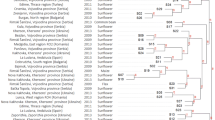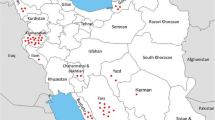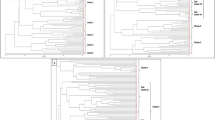Abstract
Genetic diversity analysis of Macrophomina phaseolina isolates obtained from different host range and diverse geographical locations in India was carried out using RAPD fingerprinting. Of the thirteen 10-mer random primers used, primer OPB-08 gave the maximum polymorphism and the UPGMA clustering could separate 50 isolates in to ten groups at more than 65% similarity level. The ten clusters correlated well with the geographical locations with exceptions for isolates obtained from Eastern and Western Ghats. There was a segregation of isolates from these two geographical locations in to two clusters thus, distributing 10 genotypes in to eight geographical locations. All the isolates M. phaseolina irrespective of their host and geographical origin, exhibited two representative monomorphic bands at 250 bp and 1 kb, presence of these bands suggests that isolates might have evolved from a common ancestor but due to geographical isolation fallowed by natural selection and genetic drift might have segregated in to subpopulations. Genetic similarity in the pathogenic population reflects the dispersal of single lineage in all locations in India.
Similar content being viewed by others
References
Dhingra OD and Sinclair JB (1978) Biology and pathology ofMacrophomina phaseolina. Viscosa, Brazil: Universidade Federal de Viscosa. 141 pp
Smith WH (1969) Comparison of mycelial and sclerotial innoculum of Macrophomina phaseoli in the mortality of pine seedlings under varying soil conditions. Phytopathology 59:379–382
Sutton BC (1980) The Coelomycetes. Fungi Imperfecti with Pycnidia, Acervuli and Stromata. Commonwealth Mycological Institute, Kew, Surrey, England. 696 pp
Su G, Suh SO, Schneider RW and Rusin JS (2001) Host specialization in the charcoal rot fungus, Macrophomina phaseolina. Phytopathology 92:120–126
Mayek-Pérez N, López-Castañeda C, Gonzáles-Chavira M, Garcia-Espenosa R, Acosta-Gallegos J, Martinez de Vega O and Simpson J (2001) Variability of Mexican isolates of Macrophomina phaseolina based on pathogenesis and AFLP genotype. Physiol Molec Plant Pathol 59:257–264
Purkayastha S, Kaur B, Dilbaghi N and Chaudhary A (2006) Characterization of Macrophomina phaseolina, the charcoal rot pathogen of cluster bean, using conventional techniques and PCR-based molecular markers. Plant Pathology 55: 106–116
Reyes-Franco MC, Hernandez-Delgado S, Beas-Fernandez R, Medina-Fernandez M, Simpson J and Mayek-Pérez N (2006) Pathogenic and genetic variability within Macrophomina phaseolina from Mexico and other countries. J Phytopathol 154:447–453
Babu KB, Srivastava AK, Saxena AK and Arora DK (2007) Identification and detection of Macrophomina phaseolina by using species-specific oligonucleotide primers and probe. Mycologia 99:733–739
Jana TK, Singh NK, Koundal KR and Sharma TR (2005) Genetic differentiation of charcoal rot pathogen, Macrophomina phaseolina, in to specific groups using URP-PCR. Can J Microbiol 51:159–164
Jana TK, Sharma TR and Singh NK (2005) SSR based detection of genetic variability in the charcoal root rot pathogen Macrophominba phaseolina. Mycol Res 109: 81–86
Jaccard P (1908) Nouvelles researches sur la distribution florale. Société Vaudoise des Sciences Naturelles Bulletin 44:223–270
Rholf FJ (2000) NTSYS-pc. Numerical Taxonomy and Multivariate Analysis System, Version 2.1. Setauket, NY, USA: Exeter Publishing
Vandemark G, Martnez O, Pecina V and Alvarado MJ (2000) Assessment of genetic relationships among isolates of Macrophomina phaseolina using a simplified AFLP technique and two different methods of analysis. Mycologia 92:656–664
Jana TK, Sharma TR, Prassad RD and Arora DK (2003) Molecular characterization of Macrophomina phaseolina and Fusarium species by a single primer RAPD technique. Mcrobiol Res 158:249–257
Das IK, Fakrudin B and Arora DK (2008) RAPD cluster analysis and chlorate sensitivity of some Indian isolates of Macrophomina phaseolina from sorghum and their relationships with pathogenicity. Microbiol Res 163: 215–224
Fuhlbohm M (1997) Genotypic diversity among Austrialian isolates of Macrophomina phaseolina. XX Biennial Australian Plant Pathology Society Conference. Lincoln University, New Zealand, 52 pp
Alvaro MRA, Ricardo VA, Carlos AAA, Valdemar PC, David SJF, Silvana RRM, Luis CB, Mauro CP and Claudio GPC (2003) Genotypic diversity among Brazilian isolates of Macrophomina phaseolina revealed by RAPD. Fitopatologia Brasileira 28:279–285
Carlile MJ (1986) Genetic exchange and gene flow: Their promotion and prevention. In: Evolutionary Biological of the Fungi. (Rayner ADM, Brasier CM and Moore D eds) Cambridge University Press, Cambridge, pp 203–214
Author information
Authors and Affiliations
Corresponding author
Rights and permissions
About this article
Cite this article
Babu, B.K., Reddy, S.S., Yadav, M.K. et al. Genetic diversity of Macrophomina phaseolina isolates from certain agro-climatic regions of India by using RAPD markers. Indian J Microbiol 50, 199–204 (2010). https://doi.org/10.1007/s12088-010-0033-x
Received:
Accepted:
Published:
Issue Date:
DOI: https://doi.org/10.1007/s12088-010-0033-x




